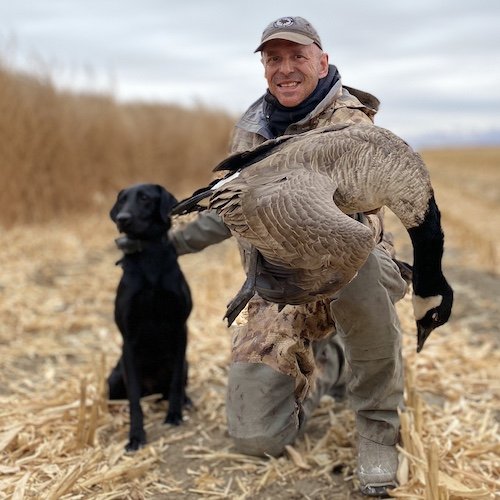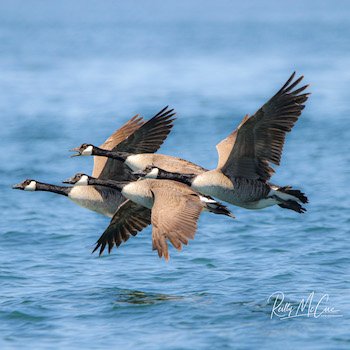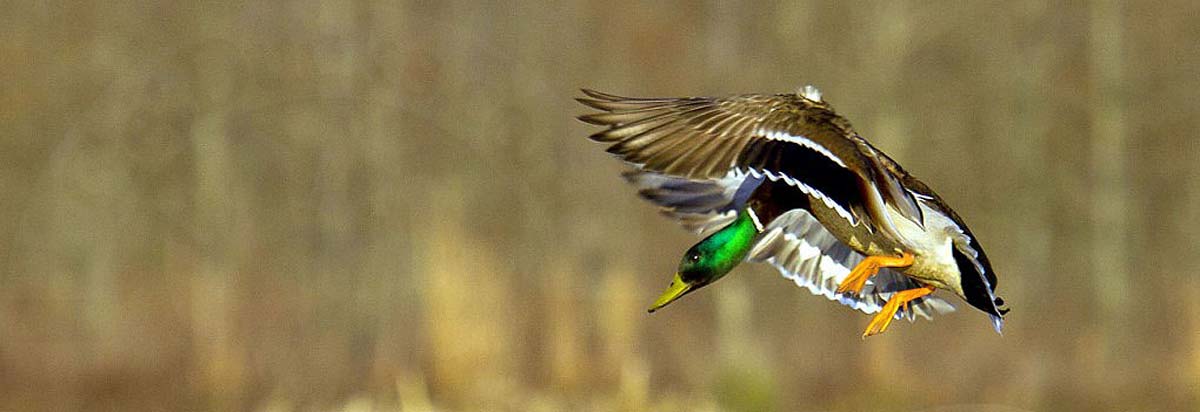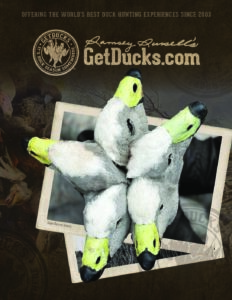Canada Goose

Canada Goose (Branta canadensis) is one of the most iconic and recognized North American waterfowl species. There are 7 Canada goose subspecies, including the Atlantic, Interior, Giant, Lesser, Western, Dusky, and Vancouver Canada Goose, and differences are not easily distinguished because many geographical areas are integrade zones for one or more races. Until 2004, the 11 subspecies comprising Canada Geese and Cackling Geese were all classified as “Canada Goose subspecies.” Now, because of genetic differences, Canadas and their smaller forms, cacklers, are classified as stand-alone species. Typical Canada Geese characteristics include a black bill, legs/feet, head, neck, and tail feathers; a white patch on the cheek and breast; and an overall brown-gray body. In flight, a white horseshoe may be seen on the rump surrounded by black plumage. Sexes display similar plumage, and males are only slightly larger than the females. It has been observed that there is an east-west coloration cline: lighter subspecies are found in the East and darker subspecies are usually found in the West.
Available Hunts
-
Alberta Canada Duck and Goose Hunt
Ranchland Outfitters best-of-best Alberta Canada Duck and goose hunting packages feature excellent waterfowl hunts, world-class food, unrivaled hospitality.
...read more- Inclusive Ranchland Outfitters package includes lodging and meals, professional guide services, scouting, ammo, hunting transfers, and bird processing.
- Choose either 3- or 6-day packages
- September through early November, and even into mid-December!
- Specializes in exclusive groups of 6-8, but smaller groups welcomed, too
- Millions acres stretching from boreal forest to US border
- Mallards, pintails, Canada geese, cackler geese, snow geese, white-fronted geese.
Rate: $3,750 hunter packages -
Kansas Duck and Goose Hunting
Big Kansas Outdoors delivers high-energy, action packed Kansas duck and goose hunting in Central Kansas. It's the kind of waterfowl hunting for which Kansas has become famous.
...read more- Dry-field and wetland hunts for ducks and geese
- Waterfowl-only and waterfowl-upland combos
- Value-priced packages include lodging and meals
- Full-time scouts find the active feeds, full-time guides make it happen
- Within a day’s drive for most of the US
- As featured on The Grind and Heartland Waterfowl
Rate: $1,800+ (3-day waterfowl-only) -
Nebraska Duck Hunt
World-class Nebraska duck hunting targeting mallards and Canada geese in the fabled North Platte River Valley. Long-time professional outfitter has a proven track-record for success in Nebraska and Wyoming.
...read more- High-quality duck hunting experiences for mallards and migrator Canada geese along legendary North Platte River
- Impressive 95% repeat-client bookings for past decade, completely sold out last 10 years
- Duck hunting eastern Wyoming and western Nebraska
- Professionally guided duck hunts, experienced guides, heated blinds, premier private properties
- Choose hotel and private lodging-style accommodations. Local meals available nearby
- Private air services within minutes, commercial air services in Denver (3 hours)
Rate: $2,100 GROUP (see details) -
Nebraska Waterfowl Hunts
Great Nebraska waterfowl hunting. SIXTEEN MILES of fabled North Platte River duck hunting area on nearly 400,000 acres associated properties under exclusive wraps. Expect some of North America's very best mallard and big Canada goose hunting.
...read more- Mallards and big Canada geese. LOTS of them. Central Flyway limits of 6 ducks (5 mallards) and 5 honkers daily
- North Platte River, adjacent agriculture, miles of hot-springs sloughs that never freeze
- Comfortable lodging, excellent meals, professional guide services, heated pits
- Accommodates 3-6 waterfowl hunting guests
- Located 3.5 hours from Denver airport; only 45 minutes from Scottsbluff, Nebraska
Rate: $2,500-$3,500 packages -
New England Sea Duck Hunting
World renown for its eider hunting, New England waterfowling offers an incredible change of scenery and is an excellent place to check off lots of North America waterfowl species. Codfather Charters specializes in making your hunt priorities a reality.
...read more- Decade-plus experience for trophy eiders, other sea ducks, divers, dabblers, mergansers, geese
- Best place in US to harvest prime American black ducks
- Customized hunt plans reflect hunter priorities, not a “one size fits all” type 1/2-day hunt
- Includes hotel accommodations, full-day hunting, continental breakfasts, made-to-order lunches
- Recognized as foremost among US waterfowl collectors and taxidermists
- Nearby non-hunting spouse activities abound
Rate: $2,500 for 3-day inclusive package -
North Dakota Pheasant Hunting Combo
Guided North Dakota Pheasant Hunting package offers options for pheasant hunting only, or a true pheasant hunting plus waterfowl hunting combo. Ringneck Resort represents a long-standing reputable outfitter program and highly experienced guide-staff..
...read more- North Dakota pheasant hunting combo to include waterfowl hunting
- Pheasant hunting-only packages available (wild, preserve or both)
- Inclusive packages includes signature meals, well-stocked bar
- Spacious, well-appointed lodge sleeps 48 guests. Ensuite rooms.
- Solo hunters welcome. No party-size too big or too small
- Bring your own dogs or hunt over Ringneck Resort’s excellent dog power
Rate: $2,750 (3-day Combo) -
North Dakota Waterfowl Hunt
Dirty Bird Outfitters delivers the best guided North Dakota waterfowl hunting experiences. North Dakota duck hunts, North Dakota goose hunts and North Dakota swan hunts are their specialties.
...read more- Guided North Dakota duck hunting combo packages
- High-success North Dakota Swan Hunts (must draw tag)
- Early- and late-season North Dakota Canada Goose Hunting
- Packages include meals and lodging
- NEW Home-away-from-home lodge (constructed 2021)
- Small, highly experienced and professional staff
- Mallards, wigeons, pintails, cackler geese, Canada geese, white-fronted geese, light geese, tundra swans
- Waterfowl hunting opportunities August through mid-December
Rate: $400-650 daily -
Oklahoma Duck Hunt
Oklahoma duck hunting a little over an hour drive from Dallas - as good as it gets. We've promoted this hunt for a very long time, always happy client feedback.
...read moreExcellently guided Oklahoma duck hunts are located a little over an hour north from Dallas. Perfect opportunity for a morning hunt before work or an easy weekend hunt with friends, family or business associates.
- Located 1 to 1.5 hours from downtown Dallas
- Expertly-guided Oklahoma duck hunts, afternoon hog hunting available
- Oklahoma and Texas depending on bird activity
- Mostly dry blinds, waders not always needed
- Cabin accommodations for up to 8 can be provided
- Meals not included
Rate: $400 per morning -
Saskatchewan Canada Goose and Duck Hunting
Northern Skies Outfitters - energetic staff is detailed oriented, proven experience delivering the classic prairie Canada waterfowl hunting adventures.
...read moreClassic, action-packed Saskatchewan Canada field hunting for geese and ducks in the Land of Living Skies!
- ALL-INCLUSIVE Choose from 3- to 6-days (or more)
- Excellent decoys and gear, professional guides and spotters
- Famous “Tiki Hut” Blind super comfortable
- Perfectly quaint lodge accommodations, home-cooked meals
- Canadas, cacklers, light geese, specks, mallards, pintails
- Solo hunters accepted; 11-hunters minimum exclusive group
- Thousands square-miles of hunting area well off beaten path
Rate: $2,975 (3-day) -
Saskatchewan Canada Waterfowl Hunts
Prairie Limits Outfitters delivers superior Saskatchewan Canada waterfowl hunts in "The land of Living Skies."
...read moreDelivering consistently great Saskatchewan Canada waterfowl hunts is what Prairie Limits Outfitters does. Young energetic staff of go-getters are highly experienced.
- Mostly dry-field hunts for Canadas, cacklers, white-fronts, snows, mallards and pintails, sandhill cranes
- Choose between 3- or 5-day waterfowl hunting packages
- INCLUSIVE packages, choose either Fully Guided or Premier hunting experiences
- New lodge conveniently located to community amenities
- Fly into either Saskatoon SK or Edmonton AB
Rate: $2,800 and up
 Canada goose reintroductions have created resident goose populations that, along with migrators, can now be found thriving in suburban and urban areas. Breeding areas are found in all Canadian provinces and all continental United State, with highest densities in Canada. During the breeding season their diet consists of grasses and sedges. When migrating, they will fly in the “V” formation with the more experienced geese leading at the front of the flock. Canada Geese are skilled at removing corn kernels from old corn cobs. They frequent agricultural fields and prefer to forage on land. Their wintering grounds are similar to their breeding grounds as they are found from southern Canada down to northern Mexico. Subspecies generalized below:
Canada goose reintroductions have created resident goose populations that, along with migrators, can now be found thriving in suburban and urban areas. Breeding areas are found in all Canadian provinces and all continental United State, with highest densities in Canada. During the breeding season their diet consists of grasses and sedges. When migrating, they will fly in the “V” formation with the more experienced geese leading at the front of the flock. Canada Geese are skilled at removing corn kernels from old corn cobs. They frequent agricultural fields and prefer to forage on land. Their wintering grounds are similar to their breeding grounds as they are found from southern Canada down to northern Mexico. Subspecies generalized below:
Atlantic Canada Goose (B. c. canadensis) is the nominate race; most plentiful of the subspecies found on the east coast and prefer to breed near bog- or fen-like habitats. Bill length 48-65 mm. Breeds southeast Canada and northeast US, wintering primarily Atlantic Coast.
Interior Canada Goose (B. c. interior) may be easily confused with the Atlantic Canada Goose, but has more distinct barring on its grayish underbelly. Bill length 43-64 mm. Breeds east and south of Hudson Bay wintering historically southeastern US but now believed primarily to overwinter much further north.
Giant Canada Goose (B. c. maximus) is largest race, has the longest neck and is also one of the lightest in overall plumage color. This is the least vocal of all subspecies. Bill length 60-68 mm. Chiefly a resident of Great Plains region but has become proliferate through the US due to reintroduction programs.
Lesser Canada Goose (B. c. parvipes) displays the characteristic white cheek patches; however, they will often extend under the head. Bill length 36-49 mm. Breeds Arctic Canada west to eastern Alaska, wintering interior California and also Gulf Coast and into Mexico.
Western Canada Goose (B. c. moffitti) shares the same light plumage. An alternate name for this species is the Great Basin Canada Goose. Bill length 36-49 mm. Breeds Great Basin region, wintering western US.
Vancouver Canada Goose (B. c. fulva) uniformly dark rufous. Bill length 45-60 mm. Resident British Columbia to southern Alaska, wintering as far south as Northern California.
Dusky Canada Goose (B. c. occidentalis) is darker and smaller than Vancouver. Bill length 41-48 mm. Breeds coastal southern Alaska, watering Vancouver and Oregon; and is protected throughout most of its wintering range due to nesting ground-related population reductions.
For reasons previously noted, differentiating Canada goose subspecies should be predicated on more than general descriptions. Ducks, Geese and Swans of North America (Belrose 1980) depicts breeding grounds, migrational corridors and wintering areas, and also provides additional biometric data such as tarsus lengths. This information is helpful in tackling Canada Goose subspecies identification.







